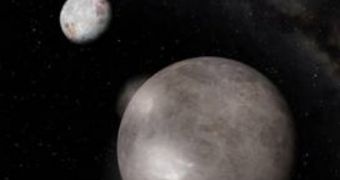Charon is the largest satellite of the now dwarf planet Pluto, also referred to as Pluto I, over half the diameter of Pluto, dominated by what was thought to be stable water ice and it has no atmosphere.
It is largely an icy body and contains less rock by proportion than its partner Pluto, supporting the idea it was created by a giant impact into Pluto's icy mantle.
New observations of the satellite revealed an interesting characteristic, the fact that geysers on its surface are constantly coating the small celestial body with new layers of ice, like a slow but steady ice machine.
The new layer is trickling out as slow as a glacier on Earth, and is a 1-millimeter deep ice covering the entire surface. It is believed to be renewing itself every 100,000 years. Although no images of the actual geysers were actually taken, the ice layer was discovered by tracing the spectral fingerprints of ammonia hydrates and water crystals in light coming from the moon.
Deep inside Charon, ammonia-laced liquid water is constantly seeping out through small cracks on the frozen surface, most likely due to a phenomenon called cryovolcanism, that produces the eruption of liquids and from inside the moon.
"Our spectra point consistently to cryovolcanism, which brings liquid water to the surface where it freezes into ice crystals," said study leader Jason Cook of Arizona State University. "That implies that Charon's interior possesses liquid water."
Something is definitely happening with Charon and scientists believe radioactive materials in its interior could create a pool of liquid water just below the surface, which is mixed with ammonia. "As some of the subsurface water cools and approaches the freezing point, it expands into the cracks in the ice shell above it," Cook explained.
This liquid water freezes immediately after it reaches the surface and snows back to produce bright ice patches that are visible in the infrared.
"The real proof will come from the deep-space NASA probe New Horizons, which will arrive at this system in 2015 and send back images that can verify what we've seen," concluded Cook.

 14 DAY TRIAL //
14 DAY TRIAL //